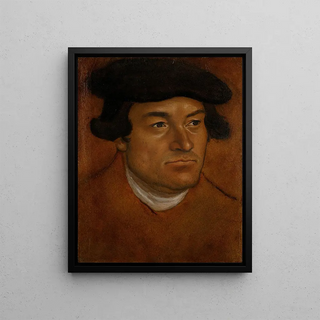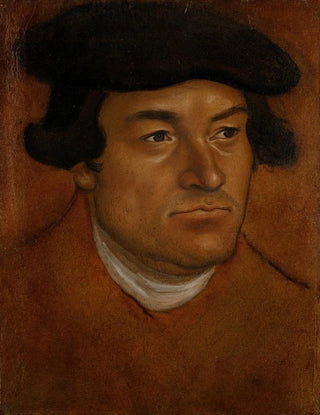Art print | Portrait of a man with a black cap - Lucas Cranach the Elder


View from behind

Frame (optional)
Portrait of a Man with a Black Cap - Lucas Cranach the Elder – Captivating Introduction
The "Portrait of a Man with a Black Cap" by Lucas Cranach the Elder is a work that embodies the very essence of German Renaissance art. Created in the early 16th century, this painting not only showcases the undeniable talent of its creator but also reflects the cultural and social atmosphere of its time. The depiction of a man with penetrating eyes, wearing a black cap, immediately captures interest and invites deeper contemplation. Every detail, from the nuances of color to facial features, tells a story that transcends time and space. Thus, this art print offers access to a rich and fascinating artistic universe where beauty and psychological depth converge.
Style and uniqueness of the work
Lucas Cranach the Elder's style is distinguished by finesse in execution and meticulous attention to detail. In this portrait, the artist uses a subdued color palette that highlights the subject's face. The man, whose gaze seems to scrutinize the viewer, is enveloped in an atmosphere of mystery. Delicate shadows and skillfully placed lights give his face an almost sculptural dimension. The black cap, the centerpiece of the composition, adds a touch of modernity to this timeless work. Cranach, as a master of portraiture, manages to capture not only the physical appearance but also the personality of his model, creating an emotional connection between the viewer and the subject.
The artist and his influence
Lucas Cranach the Elder, born in 1472, is one of the most influential artists of the German Renaissance. His work marked his era, not only through his refined technique but also through his commitment to humanist ideas that prevailed at the time. Cranach established himself as a renowned portraitist, counting among his patrons emblematic figures of his era, including Martin Luther. His unique style has inspired many artists, and his influence is still felt in contemporary art. By exploring themes such as beauty, virtue, and morality, he contributed to shaping the perception of the individual in art. The art print of

Matte finish

View from behind

Frame (optional)
Portrait of a Man with a Black Cap - Lucas Cranach the Elder – Captivating Introduction
The "Portrait of a Man with a Black Cap" by Lucas Cranach the Elder is a work that embodies the very essence of German Renaissance art. Created in the early 16th century, this painting not only showcases the undeniable talent of its creator but also reflects the cultural and social atmosphere of its time. The depiction of a man with penetrating eyes, wearing a black cap, immediately captures interest and invites deeper contemplation. Every detail, from the nuances of color to facial features, tells a story that transcends time and space. Thus, this art print offers access to a rich and fascinating artistic universe where beauty and psychological depth converge.
Style and uniqueness of the work
Lucas Cranach the Elder's style is distinguished by finesse in execution and meticulous attention to detail. In this portrait, the artist uses a subdued color palette that highlights the subject's face. The man, whose gaze seems to scrutinize the viewer, is enveloped in an atmosphere of mystery. Delicate shadows and skillfully placed lights give his face an almost sculptural dimension. The black cap, the centerpiece of the composition, adds a touch of modernity to this timeless work. Cranach, as a master of portraiture, manages to capture not only the physical appearance but also the personality of his model, creating an emotional connection between the viewer and the subject.
The artist and his influence
Lucas Cranach the Elder, born in 1472, is one of the most influential artists of the German Renaissance. His work marked his era, not only through his refined technique but also through his commitment to humanist ideas that prevailed at the time. Cranach established himself as a renowned portraitist, counting among his patrons emblematic figures of his era, including Martin Luther. His unique style has inspired many artists, and his influence is still felt in contemporary art. By exploring themes such as beauty, virtue, and morality, he contributed to shaping the perception of the individual in art. The art print of






